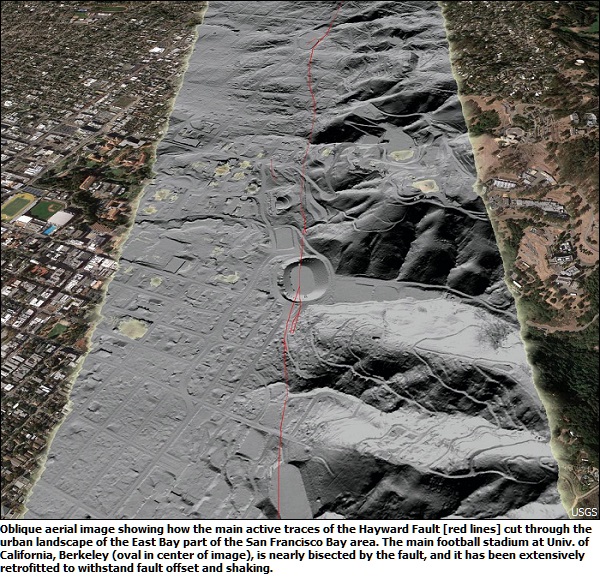
|
|

|
|
| April 24, 2024 |
|
Earthquake warning: Just how bad is Hayward Fault’s nightmare scenario? 
SAN FRANCISCO--Eight hundred deaths, 18,000 people injured, more than $82 billion in property damage and business losses, and 400 fires that would claim more lives and permanently alter the urban landscape of the San Francisco Bay region.
That’s the nightmare scenario of what might happen if a 7.0 magnitude earthquake fractured today on the Hayward Fault under Oakland, according to a new report by the U.S. Geological Survey and 60 partners, released Wednesday. The report, called the HayWired Scenario, is not a prediction, it’s a model, or hypothetical depiction. A real earthquake on the Hayward Fault could fracture at a different spot, with a different pattern of shaking, causing damage at different spots, with different casualties. But it’s an important wakeup call for a region that is still busy preparing for cataclysm. The HayWired scenario was developed to guide residents and policymakers in earthquake-risk reduction and resilience-building actions. Such actions taken now, before an earthquake, will help reduce injuries, damage and losses to buildings and infrastructure, and the number of people displaced from their homes — shortening our recovery time when the next earthquake occurs. “I would give the Bay Area a solid ‘A’ in preparedness — but that’s a midterm grade. People need to keep going, keep working hard and earn an ‘A+’ on the final,” said Pasadena-based Ken Hudnut, USGS Science Advisor for Risk Reduction and one of the lead authors of the HayWired Earthquake Scenario report. In the nearly 30 years since the Loma Prieta earthquake, the Bay Area has invested at least $25 billion, and possibly as much as $50 billion, in earthquake countermeasures, such as strengthening buildings, roads, rails, wires, and water supplies, according to the report. However, the HayWired earthquake scenario shows that there is still more to be done. The Silicon Valley will experience a 6.4 magnitude aftershock following the earthquake, according to the scenario. This is the first time that the HayWired team studied the impact of aftershocks, motivated by the massive damage following 2011’s Christ Church, New Zealand temblor. There’s at least a 20 percent chance that an aftershock as large as magnitude 6.4 would occur after a real magnitude 7.0 earthquake, they said. “A lot of the cities (in Silicon Valley) are already really well prepared,” said Hudnut. In particular, “San Jose has its act together. Keep doing that good stuff, working in the right direction.” The Hayward Fault, which runs along the eastern side of San Francisco Bay, is among the most active and dangerous in the United States, because it runs through our densely urbanized and interconnected region with a population of more than 7 million people. Major earthquakes on the Hayward Fault have occurred about once every 100 to 220 years during the past 1,900 years. On average, for the past 12 major earthquakes on the fault, the interval between events has been about 150 years, plus or minus 60 years. The last major earthquake on the Hayward Fault was a magnitude-6.8 earthquake in 1868, 150 years ago. The massive 1906 earthquake, that along with widespread fires left more than 700 dead, jolted San Francisco 112 years ago Wednesday along the San Andreas Fault. Since 2014, the USGS has worked on the HayWired scenario with representatives of organizations in the San Francisco Bay region. These have included 80 fire-department chiefs, dozens of emergency managers, and many representatives from utilities, transportation agencies and the information technology industry. A scientific report was issued by USGS last year. What was new on Wednesday was the team’s engineering report. Specifically, studies done for the HayWired scenario show that damage from the shock could: · Render older steel-frame high-rise office buildings and newer reinforced-concrete residential buildings in downtown Oakland and San Francisco unusable for as long as 10 months. · Displace about 77,000 households, and if other factors (such as utility outages and fires) are included, the damage could displace as many as 152,000 households or about 411,000 people. · Cause 0.4 percent of buildings to collapse, 5 percent to be unsafe to occupy, and 19 percent could have restricted use. “More resilient buildings constructed to more stringent building codes could allow 95 percent of the bay region’s population to remain in their homes and workplaces following such an earthquake,” according to the report. An earthquake early warning system such as ShakeAlert could prevent as many as 1,500 of the 18,000 nonfatal injuries if the system were fully implemented for the region, and if people heeded alerts to promptly “Drop, Cover, and Hold On.” However, hundreds of more lives would be lost due to fire, according to the scenario. During and soon after the shock, more than 400 gas- and electric-related fires could ignite, triggering conflagrations that might be as destructive as the powerful ground shaking, the report says. Residential and commercial building space equivalent to more than 52,000 single-family homes could burn. And the fires would cause additional property losses approaching $30 billion. The motto of the HayWired campaign, “Together, we can outsmart disaster,” is a call to action for statewide engagement to strengthen business and lifeline resilience and to reduce risk from an earthquake like the one modeled in the terrifying scenario. “Preparing for the next large, damaging earthquake in the San Francisco Bay region is not an insurmountable task,” it concludes. (Source: The Mercury News) Story Date: May 4, 2018
|